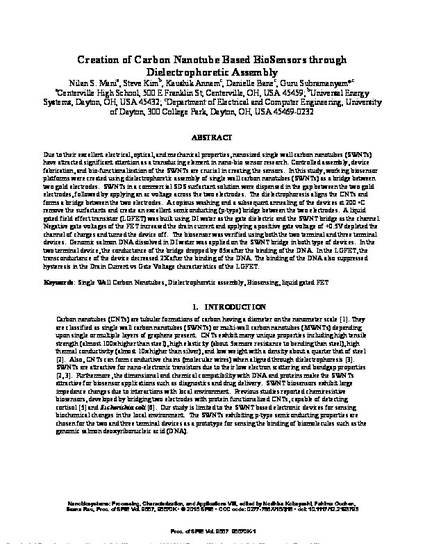
Due to their excellent electrical, optical, and mechanical properties, nanosized single wall carbon nanotubes (SWNTs) have attracted significant attention as a transducing element in nano-bio sensor research. Controlled assembly, device fabrication, and bio-functionalization of the SWNTs are crucial in creating the sensors. In this study, working biosensor platforms were created using dielectrophoretic assembly of single wall carbon nanotubes (SWNTs) as a bridge between two gold electrodes. SWNTs in a commercial SDS surfactant solution were dispensed in the gap between the two gold electrodes, followed by applying an ac voltage across the two electrodes. The dielectrophoresis aligns the CNTs and forms a bridge between the two electrodes. A copious washing and a subsequent annealing of the devices at 200 ᵒC remove the surfactants and create an excellent semiconducting (p-type) bridge between the two electrodes. A liquid gated field effect transistor (LGFET) was built using DI water as the gate dielectric and the SWNT bridge as the channel. Negative gate voltages of the FET increased the drain current and applying a positive gate voltage of +0.5V depleted the channel of charges and turned the device off. The biosensor was verified using both the two terminal and three terminal devices.
Genomic salmon DNA dissolved in DI water was applied on the SWNT bridge in both type of devices. In the two terminal device, the conductance of the bridge dropped by 65x after the binding of the DNA. In the LGFET, the transconductance of the device decreased 2X after the binding of the DNA. The binding of the DNA also suppressed hysteresis in the Drain Current vs Gate Voltage characteristics of the LGFET.
Available at: http://works.bepress.com/guru_subramanyam/42/

This document is provided for download in compliance with the publisher's policy on self-archiving. Permission documentation is on file.